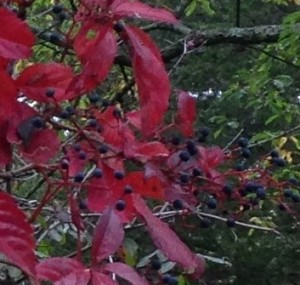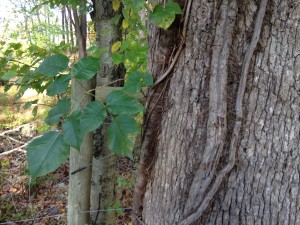Hello fellow readers, What a treat to visit Elisabeth, a delightful client who moved back from Chicago to be near her family. She painted her renovated and restored farmhouse built in the 1800s in a dramatic yet soothing shade of dark gray with black trim. And implemented the landscape design we worked on to enhance the gorgeous property’s views and function while being kind to the wildlife, adding her flair – a delight to see.

1800s Farmhouse – “Before.”

Elisabeth is tending to her native plant garden.
Virginia Creeper vs. Poison Ivy
Elisabeth has been pulling Virginia Creeper vines from her trees, which I never considered a dilemma. While it grows rampant in the wild, Parthenocissus quinquefolia is a native plant and, therefore, not regarded as invasive, and folks value it as an ornamental plant.
Just as is its look-alike, Poison Ivy, wildlife adores Virginia Creeper. Of course, Poison Ivy (Toxicodendron radicans) is not an ornamental plant, though it is lovely too. Both turn a glorious bright red in fall. Fortunately, it’s easy to tell the difference between Virginia Creeper and Poison Ivy beyond the itch.
The tell-tale sign is that Virginia Creeper has five leaflets – Poison Ivy has three. And Virginia Creeper has dark purple berries in the fall, while Poison Ivy has greyish-white ones.
Virginia Creeper berries contain oxalic acid, which is moderately toxic to humans and other mammals but provides a food source for birds. The sap of the plant has needle-shaped crystals of calcium oxalate. Crushing the leaves can prick the skin, causing irritation and blisters to some, so wear gloves when handling.

Design by Mary Stone, Stone Associates Landscape Design & Consulting

“I Dare You” Challenge
When I was a girl, my sister dared me to rub a leaf all over me. Even then, I was a plant person and always up to an “I dare you” challenge. The leaf was in a grouping of three, and I picked one and dutifully painted myself with it. I bet you know where this is going.
I’m allergic to poison ivy, as are about 80 percent of us – some more than others. My reaction was awful (big surprise), causing my eyes to swell shut. Most people will react more to repeated or extreme exposure, such as what dear Sis challenged me to do. Long forgiven, though my counter challenge to ride the red flyer wagon down the steep drive left permanent scars on her knees. :^0

Poison Ivy Berries

Virginia Creeper Berries
Both vines are ambitious and can cover trees or shrubs and even kill them by shading their photosynthesizing ability, hence why Elisabeth pulls them from the trees. But I adore Virginia Creeper scrambling along our boulders in the rock garden. Used as an ornamental plant, it can quickly cover walls keeping a building cooler by shading the surface, and its fall color is a show-stopper.
It adheres to the surface by disks rather than penetrating roots, so it does not harm the masonry. But, as with Boston ivy, ripping the plant from the wall can damage the surface. If you kill the plant first by cutting the vine at the root, the adhesive pads will eventually deteriorate and release their grip.
Before you wrestle vines down, it’s best to ID what you are tackling.

Poison Ivy’s Hairy Vine
You may have heard rhymes to help identify poison ivy: Leaflets Three; let it be, Hairy Vine, no friend of mine, and Berries White run in fright.
Urushiol oil can remain active for years, so handling dead leaves or vines can still cause a bad reaction. And the oil can transfer to tools or pet fur than to you.
Even if you think you aren’t allergic, a whopping exposure such as cutting up a downed tree wrapped in a dead poison ivy vine at the end of our driveway may cause a bad reaction. Isn’t that right, Curt? “If it’s hairy, you better ask Mary.” Smile.
Garden Dilemmas? AskMaryStone@gmail.com (and your favorite Podcast App.)
Enjoy more of the story in the Garden Dilemmas Podcast:
Link to a related story:
Removing Poison Ivy without Chemicals


